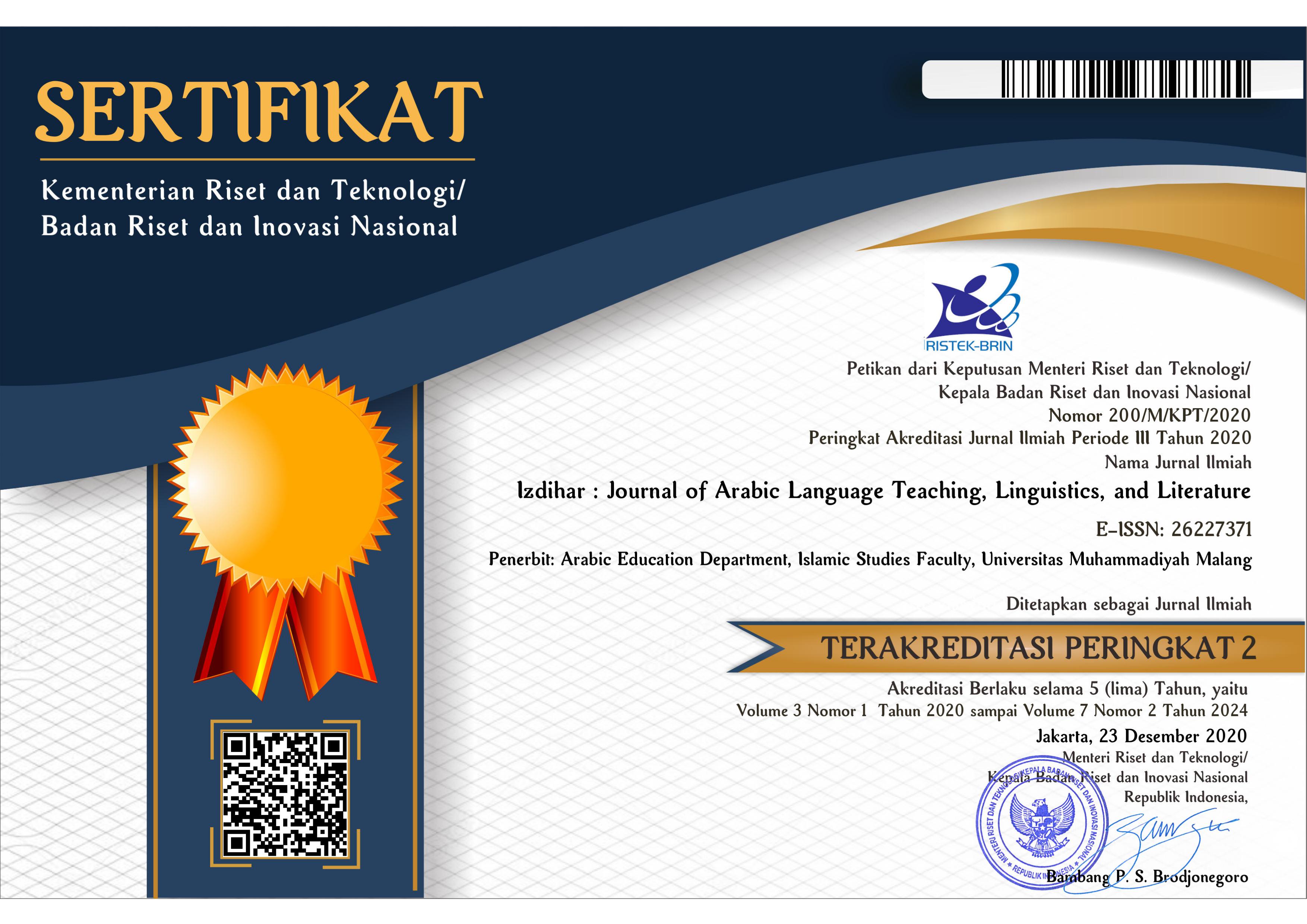Development of Pictorial Textbook for Arabic Speaking Skill in Islamic Studies Program
DOI:
https://doi.org/10.22219/jiz.v2i3.10161Keywords:
Arabic Textbooks, Islamic Studies Program, Pictorial, Speaking SkillsAbstract
This research offered solutions and answers to the textbook problems of Arabic learning in the Arabic language development program at Islamic Studies Faculty of Universitas Muhammadiyah Malang. The development of textbooks was done by adding pictorial explanations to the relevant vocabulary, also the learning material developed according to the expected profession. In addition, interactive exercises and themes were adapted to student interests and program goals. This study used ADDIE as a research and development model to produce innovative study, productive, and meaningful. The results of the validity tests were as follows: language validation tests show a percentage of 90%. The result of content validation was 92%, design validation result was 86%, while the result of lecturer validation was 95%. From these data, it can be concluded that the textbook was valid. Similarly, the effectiveness test by using (T-Test) showed effective results so that textbooks that had been developed were feasible to use.
Downloads
References
Abdullah, M., Mehdi, M., & Buriro, G. A. (2019). Language Textbook Development: A Study on Ecological, Syntactical and Literary Perspectives. International Research Journal of Arts & Humanities (IRJAH), 47(47). ISSN: 1016-9342
Abdullah, R. (2017). Pembelajaran Dalam Perspektif Kreativitas Guru Dalam Pemanfaatan Media Pembelajaran. Lantanida Journal, 4(1), 35-49. http://dx.doi.org/10.22373/lj.v4i1.1866
Amrulloh, F. S. (2016). Tathwir al-Mawad al-Dirasiyah al-'Arabiyah 'ala Asas Aghradh Khashshah li Thalabah Qism al-Mu'amalah Kulliyah al-Syari'ah bi Jami'ah 'Abdullah Faqih al-Islamiyah (INKAFA) Gresik.. Universitas Islam Negeri Maulana Malik Ibrahim. Malang: Unpublished Thesis.
Arikunto, S. (2010). Prosedur Penelitian Suatu Pendekatan Praktik (14 ed.). Jakarta: PT. Rineka Cipta.
Arumdyahsari, S., H., W., & Susanto, G. (2016). Pengembangan bahan ajar Bahasa Indonesia bagi Penutur Asing (BIPA) tingkat madya. Jurnal Pendidikan: Teori, Penelitian, dan Pengembangan, 1(5), 828-834. http://dx.doi.org/10.17977/jp.v1i5.6263
Azis, H. (2019). Validitas, Reliabilitas, Praktikalitas dan Efektifitas Bahan Ajar Cetak Meliputi Handout, Modul dan Buku. Makalah. http://doi.org/10.31227/osf.io/fcx9e
Fatoni, A. (2019). Arabic Learning for Academic Purposes. Izdihar: Journal of Arabic Language Teaching, Linguistics, and Literature, 2(2), 149-164. https://doi.org/10.22219/jiz.v2i2.10096
Fauzi, M. F., Buhun, M. F., & Purwadi, A. (2019). The Influence of Teams Games Tournament (TGT) toward Students’ Interest in Arabic Language Learning. Izdihar: Journal of Arabic Language Teaching, Linguistics, and Literature, 2(2), 135–148. https://doi.org/10.22219/jiz.v2i2.9986
Firdaus, M. (2019). Problems in Expressing Arabic Language of Indonesian Students at Khartoum International Institute for Arabic Language. Izdihar: Journal of Arabic Language Teaching, Linguistics, and Literature, 2(1), 35-52. https://doi.org/10.22219/jiz.v2i1.7588
Fischer, L., Hilton, J., Robinson, T. J., & Wiley, D. A. (2015). A multi-institutional study of the impact of open textbook adoption on the learning outcomes of post-secondary students. Journal of Computing in Higher Education, 27(3), 159–172. https://doi.org/10.1007/s12528-015-9101-x
Hamid, M. A., Hilmi, D., & Mustofa, M. S. (2019). Pengembangan Bahan Ajar Bahasa Arab Berbasis Teori Belajar Konstruktivisme untuk Mahasiswa. Arabi: Journal of Arabic Studies, 4(1), 100-114. http://dx.doi.org/10.24865/ajas.v4i1.107
Haviz, M. (2016). Research and Development; Penelitian di Bidang Kependidikan yang Inovatif, Produktif dan Bermakna. Ta'dib, 16(1). http://dx.doi.org/10.31958/jt.v16i1.235
Hendri, M. (2017). Pembelajaran Keterampilan Berbicara Bahasa Arab melalui Pendekatan Komunkatif. Potensia: Jurnal Kependidikan Islam, 3(2), 196-210. http://dx.doi.org/10.24014/potensia.v3i2.3929
Hussain, N. H., & Mamat, M. (2019). Readability Level of Arabic Texts for Upper Primary Pupils at Al-Amin Islamic Primary School (SRI). International Journal of Mechanical Engineering and Technology, 10(3).
Ibrahim, N. (2019). Pengembangan Modul Cetak Pembelajaran Remedial untuk Peningkatan Ketuntasan Belajar Mata Pelajaran Bahasa Indonesia SMP Kelas VIII. JTP-Jurnal Teknologi Pendidikan, 21(1), 75-96. https://doi.org/10.21009/jtp.v21i1.11246
Jaffar, M. N., Hameed, A., Rashid, K., & Ahmad, H. (2013). Bahasa Arab Untuk Tujuan Agama: Analisis Keperluan Pelajar Sarjana Muda Bahasa Arab dan Komunikasi di Universiti Sains Islam Malaysia. ʻUlūm Islāmiyyah Journal, 197(1024), 1-20.
Komalasari, K., & Saripudin, D. (2018). The Influence of Living Values Education-Based Civic Education Textbook on Students' Character Formation. International Journal of Instruction, 11(1), 395-410. https://doi.org/10.12973/iji.2018.11127a
Kurniawan, R., Wahyuni, E. N., & Yaqin, Z. N. (2019). Pengembangan Buku Ajar Visual Menulis Kreatif untuk Peserta Didik Madrasah Ibtidaiyah. Al-Aulad: Journal of Islamic Primary Education, 2(2), 54-63. https://doi.org/10.15575/al-aulad.v2i2.5213
Masykur, R., Nofrizal, N., & Syazali, M. (2017). Pengembangan Media Pembelajaran Matematika dengan Macromedia Flash. Al-Jabar: Jurnal Pendidikan Matematika, 8(2), 177-186. https://doi.org/10.24042/ajpm.v8i2.2014
Mujab, A. S., Irawati, R. P., & Rahmawati, N. (2018). Pengembangan Modul Bahasa Arab Berbasis Teori Psikologi Perkembangan Remaja Elizabeth B. Hurlock Kelas X MA. Lisanul'Arab: Journal of Arabic Learning and Teaching, 7(1), 1-7. https://doi.org/10.15294/la.v7i1.26068
Murdiono, M. (2018). Dira<sah Ha<lah 'an Muyu<l al-Thalabah fi< ta'allum al-Lughah al-'Arabiyyah bi al-Mada<ris al-Mutawassithah al-Islamiyah bi Malang wa Batu. Izdihar: Journal of Arabic Language Teaching, Linguistics, and Literature, 1(2).153-166. https://doi.org/10.22219/izdihar.v1i2.7297
Nurdyansyah, N. (2018). Pengembangan Bahan Ajar Modul Ilmu Pengetahuan Alambagi Siswa Kelas IV Sekolah Dasar. Universitas Muhammadiyah Sidoarjo.
Pane, A., & Dasopang, M. D. (2017). Belajar dan pembelajaran. Fitrah: Jurnal Kajian Ilmu-ilmu Keislaman, 3(2), 333-352. https://doi.org/10.24952/fitrah.v3i2.945
Permendiknas. (2016). Peraturan Menteri Pendidikan dan Kebudayaan Republik Indonesia Nomor 8 Tahun 2016 Tentang Buku yang Digunakan oleh Satuan Pendidikan Jakarta: Kementerian Pendidikan dan Kebudayaan Republik Indonesia
Prasetyo, I. (2012). Teknik Analisis Data dalam Research and Development: Jurusan PLS FIP Universitas Negeri Yogyakarta.
Salim, L. (2015). Peranan Bahasa Arab terhadap Ilmu Pengetahuan. Jurnal Adabiyah, 15(2), 172-180.
Sari, B. K. (2017). Desain Pembelajaran Model ADDIE dan Implementasinya dengan Teknik Jigsaw.
Sihotang, C., & Sibuea, A. M. (2015). Pengembangan Buku Ajar Berbasis Kontekstual Dengan Tema “Sehat Itu Penting”. Jurnal Teknologi Informasi & Komunikasi dalam Pendidikan, 2(2).
Sjahrony, A., Lubis, M. A., & Yusoff, N. M. R. N. (2017). Kepentingan Kebolehbacaan Buku Teks Dalam Dunia Pendidikan. Asean Comparative Education Research Journal on Islam and Civilization (ACER-J). eISSN2600-769X, 1(1), 25-40.
Sugiono. (2016). Metode Penelitian Pendidikan Pendekatan kualitatif, kuantitatif, dan R&D. Bandung: Alfabeta.
Rediati, A. (2015). Pengembangan Buku Pengayaan Cara Menulis Teks Penjelasan Bermuatan Nilai Budaya Lokal untuk Peserta Didik Kelas V Sekolah Dasar. Seloka: Jurnal Pendidikan Bahasa Dan Sastra Indonesia, 4(1), 1–7. https://doi.org/10.15294/SELOKA.V4I1.6849
Robinson, T. J., Fischer, L., Wiley, D., & Hilton III, J. (2014). The impact of open textbooks on secondary science learning outcomes. Educational Researcher, 43(7), 341–351. https://doi.org/10.3102/0013189X14550275
Yahya, Y. K. (2017). Usaha Bahasa Arab dalam Menghadapi Era Globalisasi. Prosiding Konfererensi Nasional Bahasa Arab, 3(3), 38-48.
Downloads
Published
How to Cite
Issue
Section
License
Copyright Notice
Authors who publish with this journal agree to the following terms:
- Authors retain copyright and grant the journal right of first publication with the work simultaneously licensed under a Creative Commons Attribution-ShareAlike 4.0 International License that allows others to share the work with an acknowledgment of the work's authorship and initial publication in this journal.
- Authors are able to enter into separate, additional contractual arrangements for the non-exclusive distribution of the journal's published version of the work (e.g., post it to an institutional repository or publish it in a book), with an acknowledgment of its initial publication in this journal.
- Authors are permitted and encouraged to post their work online (e.g., in institutional repositories or on their website) prior to and during the submission process, as it can lead to productive exchanges, as well as earlier and greater citation of published work (See The Effect of Open Access).
Copyright (c) 2019 Izdihar : Journal of Arabic Language Teaching, Linguistics, and Literature

This work is licensed under a Creative Commons Attribution-ShareAlike 4.0 International License.

















